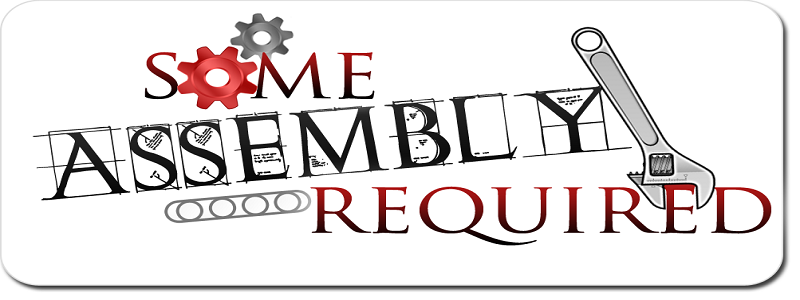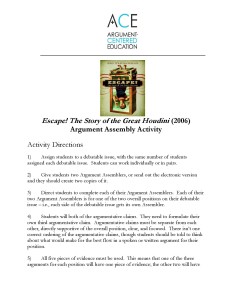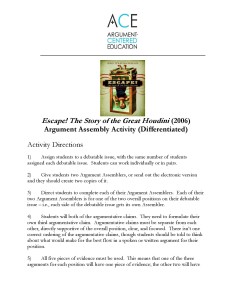
Argument Assembly Activity
On first blush, you wouldn’t think that Sid Fleischman’s 2006 biography of Harry Houdini, Escape!, would be ripe for debatification, particularly as the centerpiece of middle school reading unit. But it turns out to present a solid demonstration that argument can productively organize curriculum far beyond obvious controversial issues.
Argument-Centered Education worked with a middle school partner to argumentalize its five-week unit on Escape! for its English language arts classes, using the five steps.
We began by identifying the debatable issues embedded within the text. As we’ve written about before, identifying the central, open, and most meaningful questions in a unit is the crucial first step in argument-based curriculum planning. Debatable issues guide content delivery and absorption, and literally determine what students will be thinking most critically about throughout the unit, so they have to be selected and formulated with great care and intentionality. When a unit centers on a single complex text, it is the questions that animate the text that should form the debatable issues. The case of Escape! was actually a reminder that when one has practice finding and formulating debatable issues, it becomes rather routine. We generated a short list of options from this wide-ranging and stylishly written biography, and two rose quickly to the top:
Debatable Issue #1: Harry Houdini’s success and fame was more a result of his skills as a showman than his skills as a magician.
Debatable Issue #2: Harry Houdini’s identity stayed fundamentally the same throughout his life, despite his ascent from humble beginnings to worldwide stardom.
A moment on what we didn’t consider as options. Sometimes we see teachers formulating debatable issues that are abstracted from content in a unit in a way that makes them unfocused, detached from the text, fluffy, airy, even vapid. An example in the case of the Houdini biography might have been something like:
Do people (or, Do you) really believe in magic when they (you) see a magician as great as Harry Houdini?
or
What accounts for the continuing popularity of magic in our era of advanced science and technology?
Whatever merits and faults these questions have, they are not asked by Escape!, and debatable issues have to adhere to our curricular content. Sometimes when teachers are disappointed by the meandering or untethered quality of classroom debates, or the lack of a rigorous evidence basis to argumentation, there is an abstracted, general, unfocused debatable issue at the heart of the problem.
Second, we developed content delivery strategies organized by argument. In particular, the classes worked on student question generation and subsequent discussion. Student questions were classified by debatable issue and their relationship to positions that can be taken on them. Discussion, in this way, prepared students to look for and identify evidence, and to formulate argumentative claims, on the issues that are most central and important to an understanding of the unit content, i.e., Escape! The Story of the Great Houdini.
Third, we emphasized the use of evidence and engagement with other views in the curricular design. This was true of the content delivery and of the performance task in which it culminated. It is a relatively straightforward matter to organize student-generated questions such that they set up a clash of positions on an issue, a comparison of interpretations of passages from the text and of key moments in Houdini’s life and career, and an eliciting of arguments engaged with other arguments. The performance task (as you are about to see) focused on evidence and reasoning.
Fourth, the performance task designed for this unit was argument based. It is called the Argument Assembly Activity, and its concept is widely applicable to other content and disciplines. Here is the Argument Assembly Activity instructional guide:
And here is a differentiated version, for less advanced learners:
This activity takes some of its inspiration from a key passage in David Conley’s influential book College and Career Ready: Helping All Students Succeed Beyond High School (Jossey-Bass, 2010).
Perhaps the key foundational instructional principle necessary for all students to be more college ready is to keep the challenge level constant and vary the amount of support, or scaffolding, that is provided. In practice, this means that all students are given intellectually engaging assignments drawn from content that reflects the big ideas of the subject areas necessary to be ready for college and career. These assignments require all students to develop the key cognitive strategies identified as so important to post-secondary success.
The Argument Assembly Activity has students construct high-quality, college-directed arguments, from claims, evidence, and reasoning that have been prepared for students in advance. This gives them the analytic practice of thinking through why some pieces fit better than others, and it presents them with self-constructed models of effective, rigorous argumentation that they then have to try to attain on their own as they build their own additional, parallel arguments on both sides of one of the debatable issues. The differentiated version of the activity provides students with the raw materials for all three arguments that they then have to go off and assemble, on both sides of the issue.
To give you an example of the kinds of arguments that students – even middle school students – assemble in this ACE activity, as it was adapted for Escape!, let’s look at Debatable Issue #2. Defending the position that Houdini’s identify in fact stayed fundamentally the same throughout his life, despite his going from rags to riches, these are the three arguments that the differentiated version has students assemble:
Houdini demonstrated throughout his whole life an extraordinary determination to succeed.
Another consistent theme in Houdini’s life was that appearances were not the same as reality.
And despite the challenges he faced growing up poor, Houdini always maintained a very close relationship to his family.
The more advanced students are given two of the claims above and have to create and construct a third argument on their own.
Students use Argument Assemblers to work on their construction. Taking a look at the full answer key gives you a clear idea at how substantive and college-directed the arguments they will finish with actually are.
Discussions follow in which students justify and defend their construction jobs they did with raw materials supplied, and explicate the arguments that they built on their own. They also evaluate the competing arguments to identify and reason through the stronger position on each side of the issues. Teachers can easily go further, adding components in which students choose a side and make counter-arguments against the arguments for the contrary position, or write an argument essay using the Argument Assemblers as very substantial pre-writing.
The fifth step in the argumentalization process falls out from the above rather obviously, with an assessment focus on evidence and one of the other five components, at the teacher’s discretion.
What we hope is most obvious from this description is the underlying utility of the Argument Assembly Activity. We anticipate that it will join our other most widely used argument-based curricular templates. Give the students the raw materials for argument construction, and then require that they assemble exemplary argument models on the unit content first, create and construct their own parallel arguments after that.



